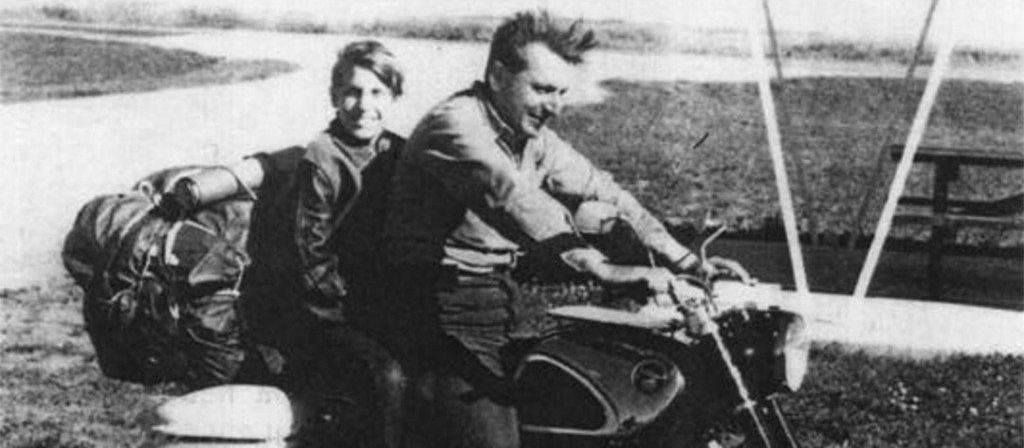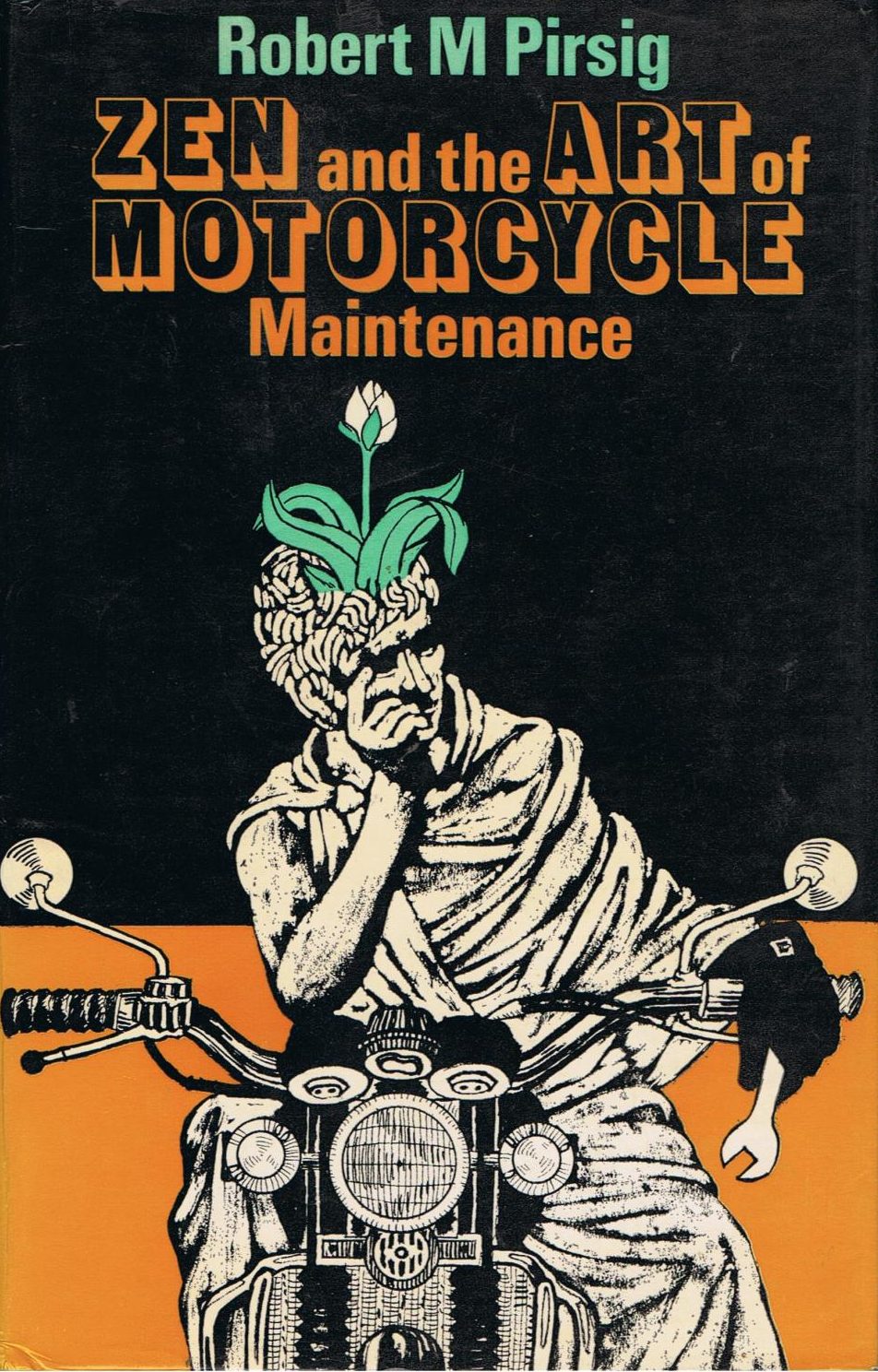

“The place to improve the world is first in one’s own heart and head and hands, and then work outward from there.”
This is a love it or hate it kind of book. Either you’ll click with Robert Pirsig’s rambling, didactic style or you’ll find it pretentious and boring. An elevator pitch of the novel might characterize it as “a story about a man and his son on a motorcycle trip across the United States punctuated by philosophical discussions.” I’ve read that type of book before—pseudo-mystical gibberish mixed with a light-hearted adventure. Books like The Alchemist or The Secret which kind of invigorate you but are really benign at best, but probably actually harmful. The kind of book that Oprah recommends. These pop-motivational texts unfortunately end up becoming “the best book I’ve ever read” for people who read an average of less than one book/year. But I had seen Zen and the Art of Motorcycle Maintenance listed as an impactful favorite by people whose tastes generally align with mine, and so I tentatively gave it a try.
Thankfully, Zen is not like those other books. Pretentious though it may be, one cannot dismiss it as easily as those lesser works. The difference is that Pirsig isn’t just trying to sell copies of his book by making you feel good about yourself or as one with the universe or whatever the current self-help work of fiction purports. In fact, he was turned down by over a hundred publishers before one accepted it without an expectation that it would sell at all.
Pirsig’s aim is to try to bridge a divide between rational thought and feeling, between the rigid structure of scientific pursuit and artistic endeavor, between the hippies and the industrialists, between technology and nature, between our external and internal selves, between the mind and the spirit. He pursues this end in a suitably pronged fashion, by writing a novelistic autobiography that contains both narrative storytelling and the development of a system of thought. Through writing, he arrives at a “Zen” worldview which allows the hands-on, practical, working man to also be one of deep thought and contemplation. Further, in many cases, this is already true but popular perception would indicate otherwise.
An untrained observer will see only physical labor and often get the idea that physical labor is mainly what the mechanic does. Actually the physical labor is the smallest and easiest part of what the mechanic does. By far the greatest part of his work is careful observation and precise thinking. That is why mechanics sometimes seem so taciturn and withdrawn when performing tests. They don’t like it when you talk to them because they are concentrating on mental images, hierarchies, and not really looking at you or the physical motorcycle at all. They are using the experiment as part of a program to expand their hierarchy of knowledge of the faulty motorcycle and compare it to the correct hierarchy in their mind. They are looking at underlying form.
Now, bear in mind that Pirsig was diagnosed with schizophrenia and underwent electroshock therapy prior to writing the book. It’s difficult to convince yourself that willingly following his thought processes is going to be healthy for you. But his argumentation is far from a dry recitation, allowing the reader to remain engaged even in disagreement. At the very least, even if you find his postulations to be hogwash, he’s putting forth a serious conceptual framework to flounder around in. He’s not just trying to put you in a certain mood or make you think he is smart (he does come off as uber intelligent, but also as kind of a jerk).
Pirsig finally works himself up to a proposition which, stated plainly, seems sort of strange, underwhelming, and impossible at first glance: Quality is the basis of reality. Chances are, without having read the preceding portion of the book or having a robust background in metaphysical philosophy, such a phrase doesn’t really mean much. It might even sound patently absurd. But the way he gets to that central idea is somehow both methodical and loose, and entertaining enough that you don’t have to come around to his side of the argument to want to continue reading. That being said, you should probably have some interest in the scientific method, education systems, epistemology, and the history of philosophy and science if you plan to really sink your teeth into the book.
But it’s not a straightforward treatise by any means. Rather, it’s meandering, occasionally tedious, and frequently delightful as Pirsig guides the reader into the “high country of the mind.” Early on, the unnamed narrator introduces us to a ghost whom he refers to as Phædrus. In the form of what he calls Chautauquas,1 he delivers almost formal lectures on wide-ranging but subtly linked subjects that Phædrus had contemplated years ago. Through the telling, we eventually come to learn that Phædrus is the narrator himself before he suffered a mental breakdown and underwent the therapy that has left him in a semi-permanently detached state. He is now thinking his way through a lifetime of convoluted thoughts and fragmented memories to piece together the scaffolding of Phædrus’ thought in order that he may correct his former course. But the more he thinks on these things, the closer Phædrus comes to the surface of his persona.
The meat of the book is an ongoing discussion on methods of thought, and how to mentally approach things in different ways. In classroom teaching, real world examples of abstract concepts are frequently used to solidify those ideas for the students. Pirsig takes this to the extreme by utilizing an ongoing narrative to provide the nuts-and-bolts level of detail. His main subject is his motorcycle, but to put too much focus on the motorcycle would be a disservice to his general system.
I don’t really agree with a lot of Pirsig’s conclusions, though I like his approach. He’s extremely reluctant to even put a definition to his nebulous Quality, even giving his students a non-definition of: “Quality is a characteristic of thought and statement that is recognized by a nonthinking process. Because definitions are a product of rigid, formal thinking, quality cannot be defined.” I also think the title is a bit misleading, because aside from a brief section that compares Quality to the ancient principle of the Tao, he spends much more time hacking away at ancient Greek philosophy than discussing Eastern ways of thinking. It is a dense read, so perhaps I glossed over a section in which he addresses it, but I think his undefinable notion of Quality could be captured by the Aristotelian/Thomistic idea of the final cause (though I may be mistaken). But I don’t have the background to critique his system of thought as a whole; I see a few problems with it, but couldn’t tug on them enough to unravel the entire thing.
The book also contains a smattering of practical wisdom. Pirsig regularly contrasts the “classical,” mathematical, rational view of the world with the “romantic,” emotional view. The former is equations and categories and order, while the latter is mystery and whimsy. Each typically rejects the other. The book criticizes the sterile understanding of the scientific method which paints every problem-solving activity as an orderly process. He uses the replacement of a motorcycle component as his example. During the replacement, a fastener becomes stuck, and since resolving the problem of a stuck fastener is not detailed in the instructions, the instruction-follower can easily become frustrated and discouraged, even though there are more than enough ways to go about fixing the issue. The core problem is rigid thinking. At the heart of science is a mysterious force of imagination and inspiration that doesn’t belong to that sterile hypothesis-driven world. Contemplation of the problem and various possible solutions, along with practice and idle time for wandering thoughts, leads one into the “Zen” of motorcycle maintenance. Generalized, this thoughtful, combination rational/romantic view of the world is what Pirsig is preaching (I think). Be patient, consider the situation, consider what is good and what is not, allow your subconscious to help you solve the problem outside of the perceived box.
Peace of mind isn’t at all superficial, really. It’s the whole thing. That which produces it is good maintenance; that which disturbs it is poor maintenance. What we call workability of the machine is just an objectification of this peace of mind. The ultimate test’s always your own serenity. If you don’t have this when you start and maintain it while you’re working you’re likely to build your personal problems right into the machine itself.
It says something about the book that I’m putting it back onto the list to go through again some time in the future despite my disagreement with its central point. I really enjoyed Pirsig’s writing style, how he combined narrative storytelling, reflective prose, and didactic content into a meandering novel. Due to that choice of style, though, it’s sometimes hard to engage with the material on an argumentative level. I think this choice is what makes the book so popular—it’s not just a lecture outlining his Metaphysics of Quality, but a combination of that, autobiography, and road novel. It’s hard to parse and so it’s hard to pigeonhole. Pirsig, who studied biochemistry at university and became more interested in the subject of science than actually doing it as a career, ended up teaching creative writing at a small college and then enrolling in a unique course of study at the University of Chicago.2 In 2012, he was formally recognized with an honorary doctorate from Montana State, where he taught the creative writing courses, but his ideas haven’t gained substantial traction inside of academia due to his unorthodox approach and their unsystematic presentation. He was taking on Plato and Aristotle, who have formed our modern Western thought to such a degree that we don’t even recognize their influence. His whole schtick relies on a somewhat mystical understanding of the universe which grates against the standard, rational system of thought that forms the basis of academic philosophy. Regardless of my (dis)agreements with some of the ideas themselves, I thoroughly enjoyed the book and it is neat to see a serious work of philosophy created “in the wild,” so to speak, gain a popular audience and encourage people to further explore the field. Indeed, its admonishment of limited thinking has been a healthy reminder that many perceived problems are entirely confined to one’s own mind. A shift in perspective, or even better, a predisposition toward contemplation rather than frustration, will serve you better as you navigate the world.
1. The Chautauqua was an American phenomenon in the late 19th and early 20th centuries. The events were held outdoors in the summer and involved art, entertainment, educational lectures, and preaching, among other things. Pirsig adopts the term to inform the reader that his book isn’t any single thing like a novel or a dialectic or a sermon or an autobiography, but some experimental synthesis of many different things.
2. Both the creative writing classes and Pirsig’s time at the University of Chicago are covered extensively in the book.